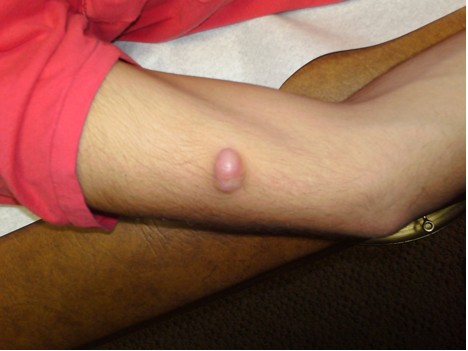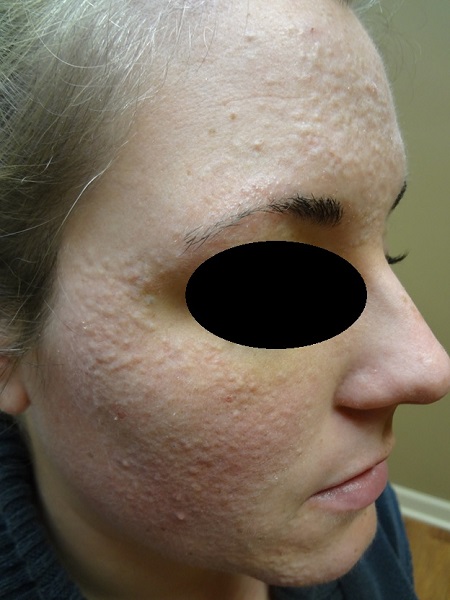CORRECT DIAGNOSIS:
Neutrophilic dermatosis of the dorsal hands
DISCUSSION:
Neutrophilic dermatosis of the dorsal hands is a fairly recently described disorder. Clinically, lesions are characterized by edematous, pustular or ulcerative nodules or plaques localized to the dorsal hands. Lesions frequently resemble those of pyoderma gangrenosum and/or Sweet’s syndrome. They are described by patients as exquisitely tender and painful, and rapidly progressive. They may or may not be associated with preceding or concurrent febrile illness. Misdiagnosis of localized cutaneous infection is common. Of the limited number of cases reported, some patients convey a history of minor trauma or chemical exposure to the hands prior to the eruption, while others have no such preceding events.
This entity was first reported in 1995 by Strutton, Weedon, and Robertson. They described lesions limited to the dorsal hands that histologically were characterized by a dense neutrophilic infiltrate, similar to that seen in neutrophilic dermatoses. At that time, the authors considered this a variant of pustular vasculitis because all of their cases demonstrated leukocytoclastic vasculitis. In similar cases, evidence of vasculitis was notably absent, so the term neutrophilic dermatosis of the dorsal hands (NDDH) was proposed by Galaria et al1, who consider this entity as a localized subset of Sweet’s syndrome. Gilaberte et al reported a case with clinical and histological findings similar to those described by Galaria et al and concluded that the presence or absence of vasculitis depends on the evolution of the lesions.
Because relatively few reported cases of NDDH exist, the possible systemic associations in these patients are somewhat unclear. In previous reports, associations of uncertain significance have included a history of breast cancer, bowel disorders (diverticulosis, diverticulitis, acute proctitis), prior pharyngitis, concurrent UTI, metastatic renal adenocarcinoma, and Raynaud disease with arthritis. A definitive link between NDDH and systemic disease processes has yet to be made. If NDDH is truly a subset of Sweet’s syndrome, an association with a preceding upper respiratory infection, myeloproliferative disorders, myelocytic leukemia, visceral malignancies, inflammatory bowel disease, connective tissue diseases, pregnancy, and drug reactions may be a possibility.
Treatment of NDDH is similar to that of Sweet’s syndrome. A good response has been reported with both oral prednisone and dapsone. Topical steroids, systemic antibiotics, and anti-fungal agents have no proven role in the treatment of NDDH.
TREATMENT:
Our patient was started on 40mg/day of oral prednisone with 60% clearance by week 2. He was tapered off prednisone and dapsone was initiated for long term management. At this time, he requires a full hematologic and gastrointestinal workup to rule out a possible underlying systemic disease that may be contributing to this dermatosis. Due to his lack of health insurance, he has declined any further evaluation at this time.
REFERENCES:
Galaria, N. A., Junkins-Hopkins, J. M., Kligman, D., & James, W. D. (2000). Neutrophilic dermatosis of the dorsal hands: Pustular vasculitis revisited. Journal of the American Academy of Dermatology, 43, 870-874. PMID: 11063061
DiCaudo, D., & Connolly, S. M. (2002). Neutrophilic dermatosis (pustular vasculitis) of the dorsal hands. Archives of Dermatology, 138, 361-365. PMID: 11850415
Gilaberte, Y., Consuegra, C., & García-Prats, M. D. (2002). Neutrophilic dermatosis of the dorsal hands versus pustular vasculitis. Journal of the American Academy of Dermatology, 46, 962-963. PMID: 12082815
Aydın, F., Sentürk, N., Yildiz, L., Cantürk, M. T., & Turanli, A. Y. (2004). Neutrophilic dermatosis of the dorsal hands in a farmer. European Academy of Dermatology and Venereology, 18, 716-717. PMID: 15353034
Strutton, G., Weedon, D., & Robertson, I. (1995). Pustular vasculitis of the hands. Journal of the American Academy of Dermatology, 32, 192-198. PMID: 7810872




